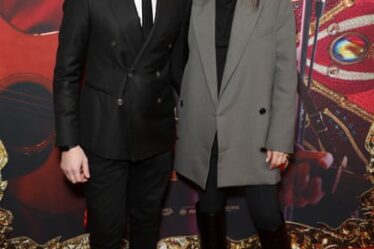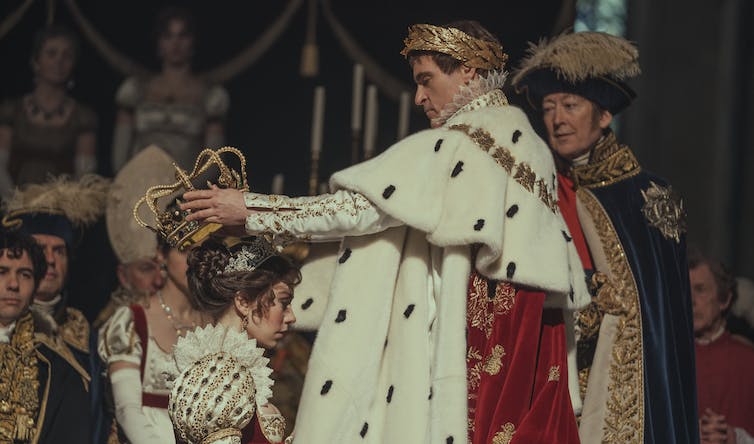
In his epic historical drama, Ridley Scott depicts Napoleon Bonaparte’s career not only through a military lens but a romantic one, suggesting that Napoleon’s global conquests were driven by a desire to conquer his wife Josephine’s heart.
The film’s trailer offers a glimpse into the couple’s coronation in 1804, a moment immortalised by the artist Jacques-Louis David.
David’s work emphasises that the coronation broke with traditional royal protocol. Traditionally, queens were not crowned directly after the king. In doing so, Napoleon was signalling the start of a new dynasty. He also invoked a historical parallel. The last queen to receive such treatment was Marie de’Medici, crowned in May 1610.
Courtesy of Apple
Josephine wore a sumptuous, high-waisted white satin gown with a red velvet train. Her fan-shaped lace collar invoked a second reference to Medici. Known as a chérusque, Medici is seen wearing the design in Ruben’s depiction of her coronation in 1624. Josephine was therefore sartorially linked to the leading figure of a powerful dynasty.
Read more:
Napoleon and Josephine’s real relationship was intense – but they loved power more than each other
Revolutionary style
Josephine’s journey to becoming empress of France was marked by tumult and tragedy. Raised in Martinique, she moved to Paris as a teenager and married Alexandre Beauharnais, a French viscount. Josephine experienced the trauma of the Revolution first-hand. Beauharnais was executed in 1794. Shortly after, she was sent to Les Carmes prison where she lived under the fear of a similar fate. By the time she was released, she found herself in a society attempting to redefine its political and cultural identity.
In such a period of uncertainty, a new fashionable set emerged. Referred to as the les Merveilleuses (the wonderful), they captivated the post-revolutionary social scene with their radical approach to dress. Corseted dresses and all their elaborate padding were eschewed for a streamlined silhouette.
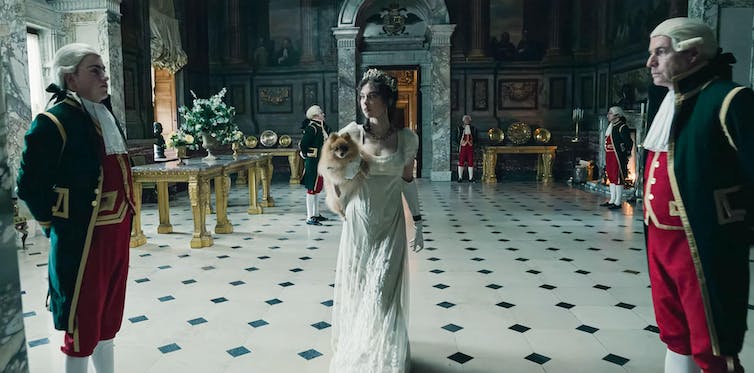
LANDMARK MEDI /Alamy Stock Photo
Embroidered silks and ruffled sleeves were disregarded for cotton muslin and flaxen linen. The towering, powdered hairstyles favoured by the old royal court were replaced by a shorn cut known as the coiffure à la victime, paying tribute to guillotined prisoners whose hair was lopped off before execution.
Paris was both enthralled and scandalised. As fashion magazines breathlessly depicted the new styles in beautiful, hand-coloured plates, other newspapers featured doctors pleading with the Merveilleuses to forsake their diaphanous dresses for fear of catching ill.
At the forefront of this movement was Josephine, who wielded such influence in fashion that she and her fellow Merveilleuses would often exchange letters before social functions, methodically planning their attire. They knew their garments would be eagerly followed, replicated and reported in painstaking detail in the French press.
Napoleon’s fashion
Napoleon’s appearance contrasted sharply with his wife’s. His contemporaries often derided him for his lacklustre style, marked by dust-ridden boots and ungloved hands. He refused to attend social functions in anything other than his uniform.
His letters to Josephine after their first meeting in 1795 show him to be utterly enamoured. In his eyes, Josephine was worldlier, older and effortlessly charming. Most importantly, perhaps, she was emblematic of two worlds: the French aristocracy of a bygone era and the new, sophisticated glitterati set he now wished to enter.

LANDMARK MEDIA/Alamy Stock Photo
Ridley Scott’s depiction of their first meeting shows Josephine sporting the popular coiffure à la victime. She’s also wearing a red ribbon – another staple of the “guillotine aesthetic”. The ribbon emphasised where the blade would have landed on a loved one’s exposed neck.
The differences between them – Napoleon, stubbornly clad in his uniform, Josephine impeccably attired in the styles she and her fellow Merveilleuses heralded – is sartorially punctuated.
Empire style
Newly wedded, Josephine visited Napoleon in Italy where she began what became a lifelong enthusiasm for cameos (a hard or precious gemstone carved with a raised relief, often depicting a person, animal or mythical scene). Attaching pieces to her belts, jewellery and headwear, she sparked a revival of the trend.
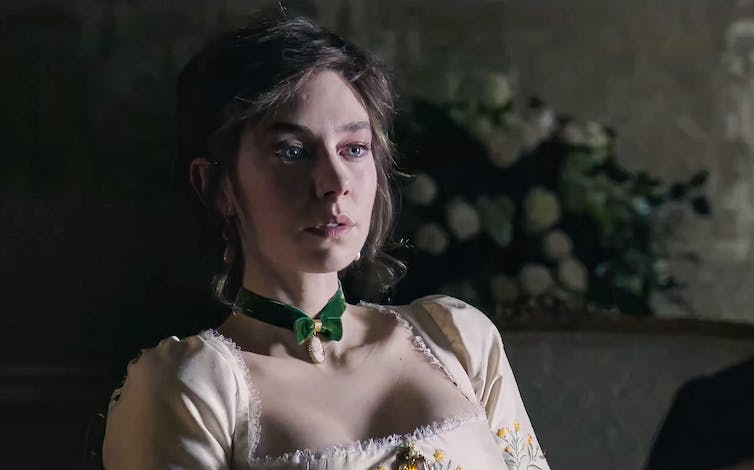
LANDMARK MEDIA/Alamy Stock Photo
Napoleon’s gifts of Kashmiri shawls during his 1798-99 Egyptian campaign turned these garments into coveted luxury staples. A shawl was often included as an item of prestige in the gift basket for affluent 19th-century brides. Josephine boasted over 400 in her personal collection and wears the shawl in several paintings.
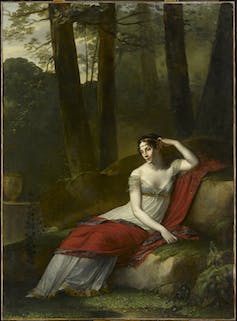
Musée de Louvre
As Empress, she became synonymous with the Empire style, marked by high-waisted dresses with tiny sleeves. White remained her preferred colour for dresses, its pale aesthetic often contrasted with a red Kashmiri shawl.
Napoleon relied on Josephine’s sartorial influence: what his wife wore, he knew, would be replicated. The fabric of her dresses changed, from the English cotton muslin she wore as a Merveilleuse to Lyonnais silk satin brocade. Her fashion choices were not only personal, they were strategic, stimulating the French luxury industry and contributing to the post-revolutionary national economy.
In 1810, after 14 years of marriage with no offspring, Napoleon and Josephine divorced. Josephine retreated to her beloved Malmaison, a country chateau outside of Paris, where she continued to receive flocks of guests and admirers until her death in 1814.
“You want to be great, but you are nothing without me,” Josephine tells Napoleon in the trailer. An apt sentiment, perhaps, for a woman whose fashion sense is imbued with historical significance and endures in cultural relevance to this day.

Looking for something good? Cut through the noise with a carefully curated selection of the latest releases, live events and exhibitions, straight to your inbox every fortnight, on Fridays. Sign up here.



